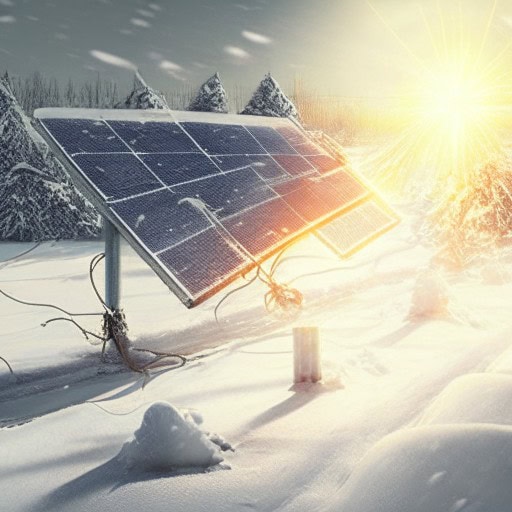Maximize Solar Energy Efficiency in Extreme Cold Weather Conditions
As a dedicated survivalist, you understand the critical importance of achieving self-sufficiency, especially when facing the challenges posed by harsh winter conditions. One of the most pressing issues you may encounter is effectively harnessing renewable energy solutions in frigid climates. The chilling cold can seem like an insurmountable obstacle, but there's no need for trepidation! This article will delve into the untapped potential of solar power in cold environments. We are poised to reveal the secrets that will enable you to harness the power of solar energy, even in the most severe winter conditions, through a proactive and informed approach.

Many people mistakenly believe that solar electricity is only viable in warm, sunny regions. However, thanks to recent technological advancements, it is entirely possible to capture solar energy even in colder climates. Let’s explore the various ways in which solar power systems can successfully thrive in extreme cold and how you can maximize this sustainable and eco-friendly energy source to benefit your lifestyle and survival strategy.
To begin with, it's crucial to understand that solar panels generate energy from sunlight rather than heat. While cooler temperatures may influence the performance of solar panels, they do not render them ineffective during winter months. By employing strategic planning and some innovative techniques, you can enhance the performance of your solar power system, ensuring it operates optimally even in the coldest corners of the globe. Understanding the mechanics of how solar panels work in various temperatures will empower you to make informed decisions about your energy needs.
One of the most vital considerations for optimizing solar electricity in cold climates is the angle and orientation of your solar panels. Properly aligning your panels can significantly increase the amount of sunlight they receive throughout the day. During winter, the sun’s trajectory is lower in the sky, making it essential to tilt your panels at a steeper angle. This adjustment allows for maximum sunlight capture, thus enhancing their efficiency. Orienting the panels towards the south can further boost their ability to collect sunlight, which is especially advantageous during the shorter days of winter.
Snow accumulation presents another challenge in colder regions that can hinder the effectiveness of your solar panels. A heavy blanket of snow can drastically reduce their electricity output. However, by approaching this obstacle with confidence, you can overcome it. Consider installing snow barriers or heating elements on your solar panels to prevent snow buildup. These modifications not only help in melting away existing snow but also ensure continuous energy production even during snowstorms. Regularly clearing snow by hand can also be an effective maintenance strategy to keep your panels operational and free from obstruction.
Incorporating battery storage systems is a forward-thinking strategy to enhance solar power efficiency in cold conditions. These batteries allow you to store surplus energy generated during daylight hours for use when sunlight is scarce or temperatures drop. The importance of battery storage becomes even more pronounced in freezing conditions, as it guarantees a steady supply of electricity when needed most. By investing in a reliable battery system, you can maintain your energy independence and be well-prepared for any unexpected situations that may arise during harsh weather.
Selecting the right type of solar panels is essential for optimizing your solar energy system's efficiency in cold climates. Certain panels are designed to perform better at lower temperatures and may include features like enhanced insulation or specialized materials to prevent frost and ice from impacting their performance. By making an informed choice about the type of panels that best suit your cold environment, you can maximize energy production and ensure that your solar power system meets your energy requirements effectively.
In addition to technical considerations, it's crucial to have your solar power system installed by professionals experienced in cold climate conditions. Expert installers can provide best practices for installation, ongoing maintenance, and troubleshooting, offering invaluable insights into optimizing your system. Their expertise will help ensure that your solar setup operates at peak efficiency, even under the most challenging winter conditions, ultimately enhancing the reliability of your energy source.
Maintaining a proactive and prepared mindset is vital in survival scenarios. While solar power can be a dependable and effective energy source in cold climates, having backup generators or alternative energy options is essential. These additional measures will serve as a safety net in case of prolonged periods of low sunlight or unexpected system failures. By integrating solar power with other renewable energy solutions, you can further enhance your energy independence and resilience, ensuring that you are well-equipped to face any weather-related challenges.
Solar energy is not limited to warm and sunny locales; it holds incredible potential even in the coldest environments, provided it is strategically planned and technically advanced. By adjusting the angles of your panels, mitigating snow accumulation, integrating battery storage, choosing suitable solar panels, relying on skilled installation, and having contingency plans, you can unlock the full potential of solar energy in extreme cold. Embrace renewable energy with confidence and resourcefulness, securing your survival and sustainability in any climate.
Off-Grid Power Solutions: Universal Energy Access
Comprehensive Overview of Off-Grid Power Solutions What Are Off-Grid Power Solutions and Their Importance? Off-Grid Power Solutions: Off-grid power solutions are self-sufficient energy systems that generate electricity independently of the central power grid. These systems are crucial for supplying energy to remote or isolated areas where traditional electrical infrastructure is either impractical or nonexistent. By harnessing […]
Water Purifier Options: A Comprehensive Guide
Exploring the Innovations in Water Purifier Technology How Do Water Purifiers Function Effectively? Water Purifier Options: Water purifiers represent sophisticated systems meticulously engineered to eradicate contaminants from drinking water, thereby guaranteeing safe consumption for users. The fundamental technologies employed in water purification encompass a range of methods, including filtration, reverse osmosis, and UV sterilization. Each […]
Urban Noise Camouflage: A Universal Solution
Enhancing Urban Life Through Effective Noise Camouflage What Constitutes Urban Noise Camouflage? Urban Noise Camouflage: Urban noise camouflage is a crucial strategy that enhances the quality of urban living by utilizing a range of advanced techniques and innovative technologies to mitigate or reduce unwanted sounds. With the increasing urban density, the challenge of noise pollution […]
Urban Predator Awareness: Protecting Communities
Comprehending Urban Predators: An Essential Guide What Are Urban Predators and Why Are They Important? Urban Predator Awareness: Urban predators refer to species that have successfully adapted to live in metropolitan areas, creating potential challenges for both human safety and local wildlife. These fascinating creatures can often be spotted in parks, residential neighbourhoods, and even […]






I loved this piece! It’s funny how people think snow equals no solar power, like some kind of winter wizardry. Last winter, I was convinced my panels were going to file for “vacation” after a week of overcast skies, but as it turns out, they actually did just fine. I mean, if they can power my indoor plant growing obsession during the dreariest of months, I bet they’ll pull through for a survivalist!
It’s fascinating, right? The misconceptions around solar power can really catch you off guard. I think a lot of people associate solar panels with blazing sun and warm weather, but as you found, they can still do their thing even when the skies are gray.
You’re spot on about the winter wizardry misconception! It’s funny how people often picture solar panels acting like sleepy bears, completely shutting down when the weather gets rough. Each season brings its own quirks, and snow actually has some perks for solar energy. Freshly fallen snow can act like a mirror, reflecting sunlight onto the panels and increasing their output. Plus, if you’ve got them angled right, a little bit of melting takes care of the snow buildup naturally.
You bring up some really interesting points about snow and solar panels. It’s fascinating to think about how nature can work in tandem with technology in ways that aren’t immediately obvious. I hadn’t considered the mirror effect of snow on solar output until someone mentioned it to me a while back. It really shifts the narrative from this idea that harsh winter conditions are just a hindrance.
You’ve touched on something really profound. The interaction between nature and technology often reveals perspectives that challenge our traditional views. When it comes to snow and solar panels, it’s a classic example of how we can learn from the environment rather than seeing it solely as a challenge.
It’s interesting how perceptions of solar power often miss the mark, especially when it comes to winter conditions. Your experience resonates with a lot of people. Snow covering the panels does give the impression that they become useless, but in reality, solar technology is more resilient than we tend to think. One of the neat things about solar panels is that they can actually generate power even on overcast days. It’s like they have a built-in ability to work with what they get.
You’ve hit on a common misconception about solar panels and winter weather. It’s fascinating how people often see winter as a sort of death knell for solar power, but in reality, these systems can be quite resilient. Your experience with overcast skies is a reminder that it’s not just direct sunlight that matters—diffused light still gets the job done. Plus, when it snows, those panels can actually benefit from the reflective properties of the snow, which can help them generate more power as long as they’re cleared off.
I’m so glad you enjoyed the piece! It’s amazing how resilient solar panels can be, even in winter. If you’re curious to learn more about how solar power can support all your obsessions (indoor plants included!), check out this link for some great insights!
https://survivalbite.com/LostFoods
You’ve pointed out some really interesting aspects about solar panels in winter weather. It’s funny how the general perception hangs onto the idea that cold, cloudy days spell doom for solar power. On the flip side, the science really backs up how resilient and adaptive these systems can be.
You bring up some solid points about solar panels and winter weather. It’s true that they can harness energy even when the skies are gray. I think people often underestimate how much diffused light can contribute to energy production. It’s like when you’re indoors on a cloudy day and still feel a sense of brightness—those panels can capture that too.
Your article sheds light on a topic that is often overlooked: the potential of solar energy in cold climates. As someone who has sought self-sufficiency in various forms, I’ve always found it intriguing how our understanding of renewable energy can be influenced by geographic stereotypes. The misconception that solar panels are only effective in sunny, warm areas limits the conversation around sustainable energy sources.
You bring up such an important aspect of the discussion around renewable energy. The misconception that solar panels are only effective in sunny, warm areas not only skews priorities in energy planning but also overlooks the innovative technologies being developed in response to that very challenge. Living in a colder climate myself, I’ve often been surprised by how well solar panels can perform even under a blanket of snow.
You’ve hit the nail on the head! It’s funny how people picture solar panels basking like lizards on a rock in the desert when, in reality, they’ve got a surprising resilience. I mean, those panels must have a cheerleading squad in their corner because they can still generate power when it’s cloudy and cold.
You bring up an important point about geographic stereotypes and their impact on our perception of renewable energy. The notion that solar panels are only effective in sunny, warm areas not only limits our understanding but also discourages innovation in colder regions.
This is such an intriguing topic, especially as I’ve been contemplating how best to increase my energy independence during the winter months. Many folks around me still hold onto the idea that solar power is only for sunny locales, but I’ve read about projects in Scandinavia and Canada successfully harnessing solar energy even under snow. It really illustrates how effective technology can be when adapted.
It’s great to hear that you’re thinking about energy independence, especially during the winter. The idea that solar power is only viable in sunny areas is a common misconception. It’s interesting to consider how different regions adapt their solar technologies to their unique environments.
You’re spot on about the winter solar conundrum. It’s like a polar bear at a summer beach party—people can’t quite wrap their heads around it. The truth is, solar panels aren’t picky—they just need light, not necessarily sunbathing on a tropical island. Those Scandinavian and Canadian projects are like that overachieving friend who brings their own sunshine.
“I’m glad you found the topic intriguing! For those interested in boosting energy independence, especially during winter, check out this resource that explores innovative solar solutions proven to work in colder climates.”
https://survivalbite.com/wild
Your insights about harnessing solar energy in extreme cold resonate deeply with my own experiences. Living in a region with brutal winters, I’ve often grappled with the misconception that solar power is ineffective in such conditions. However, investing in high-efficiency panels and ensuring they are clear of snow and debris has made a significant difference in my energy output during these months.
It’s fascinating to hear about your experiences in a winter climate. Many people underestimate the potential of solar power when temperatures drop. You’re spot on about high-efficiency panels; they really can make a difference.
“I’m glad to hear about your positive experience! For those looking to optimize their solar energy gains in winter, check out these resources to enhance your setup.”
https://survivalbite.com/LostFoods
It’s fascinating to see how our understanding of solar power is evolving, especially in the context of extreme cold weather. I’ve always found it intriguing that many people overlook the efficiency of solar panels in winter. In fact, the performance of solar panels can often increase in colder temperatures due to the reduction in thermal loss, allowing them to capture more sunlight, especially on clear, crisp days.
You make an interesting point about the efficiency of solar panels in winter. I’ve often found that the conversation around solar energy tends to focus heavily on its performance in sunny, warm climates, while the capabilities in colder conditions get brushed aside. It really highlights how we sometimes pigeonhole renewable energy solutions based on stereotypes rather than actual scientific data.
You bring up a crucial point about the often overlooked efficiency of solar panels in winter. Many of us tend to visualize solar energy primarily in the context of sun-drenched afternoons during the summer months. It’s easy to forget that solar technology has evolved significantly, and panels can be quite effective in colder, less sunny environments.
You raise a really valid point. The narrative around solar energy does often lean towards its effectiveness in sunny areas, which can overshadow how well it performs in different climates, like cold or even snowy regions. It’s fascinating to consider that solar panels can actually be more efficient in lower temperatures, as their performance typically improves with cooler conditions.
Absolutely, it’s crucial to consider the broader capabilities of solar technology. If you’re interested in exploring more about how solar panels perform in various conditions, check out this insightful resource!
https://survivalbite.com/LostFoods
You make a great point about how solar energy is often portrayed as more suitable for sunny locales, which can be a little misleading. It’s interesting that many people don’t realize how solar panels can still be quite effective in colder climates. In fact, I’ve heard that some locations with heavy snowfall manage to see impressive performance once the snow melts off the panels, potentially enhancing their energy output due to reflection.
You’ve touched on something really crucial! It’s fascinating how our understanding of solar energy can be skewed by common assumptions. Those snowy regions can actually benefit from some unique advantages. When snow blankets solar panels, it can create a sort of “cleaning” effect once it melts, as it often takes dirt and debris with it.
“Absolutely! It’s fascinating how adaptable solar technology can be. If you’re curious to explore more about how solar panels thrive in various climates, check out this insightful resource!”
https://survivalbite.com/wild
You bring up an interesting perspective on solar energy, and it’s true—there’s this prevailing idea that solar panels are only effective in sunny environments. It’s easy to fall into that mindset when you see all those bright, sunny rooftop installations in marketing materials. But, as you pointed out, solar technology has this remarkable capacity to adapt to various climates.
Thanks for the thoughtful comment! If you’d like to dive deeper into the impressive capabilities of solar panels across different climates, I recommend checking out this resource—it offers some great insights!
https://survivalbite.com/wild
You bring up a great point about how we often box in solar energy with those sunny stereotypes. It’s easy to forget that solar panels can actually perform quite well in colder climates. You might be surprised to know that they can create energy even when it’s cloudy or snowy. In fact, the efficiency of the panels can increase in cooler temps since they don’t overheat like they do in scorching sun.
You bring up a solid point about the performance of solar panels in winter. It’s true that they can function more efficiently in colder temperatures compared to the sweltering heat of summer. The surprise factor for many is that solar panels thrive on light, not heat, so those crisp, sunny days can really boost production, even when it’s freezing outside.
I appreciate your thoughts on the efficiency of solar panels in winter. It’s true that many people don’t realize that colder temperatures can actually boost their performance. This is often tied to the way solar cells operate; when it’s cool, they can convert sunlight into electricity more effectively. Plus, snow can act as a natural reflector, enhancing the sunlight that reaches the panels.
Your exploration of maximizing solar energy efficiency in extreme cold weather is both timely and essential, especially as more of us consider self-sufficiency in the face of increasingly unpredictable climate conditions. However, I find it crucial to dig deeper into the assumptions surrounding solar energy viability in winter. While you correctly challenge the misconception that solar panels are ineffective in cold climates, it is worth noting the multifaceted relationship between solar technology and environmental factors that can hinder performance.
It’s great to hear your thoughts on this topic! You’re spot on about the need to take a closer look at solar energy’s effectiveness in winter. While it’s true that solar panels can perform surprisingly well in cold weather—mainly because lower temperatures can actually increase their efficiency—the reality is more complex than just temperature alone.
Your exploration of solar energy efficiency in extreme cold touches on a topic that’s not only vital for survivalists but also fundamentally reshapes our understanding of renewable energy in diverse climates. I grew up in a region known for its harsh winters, and I often encountered the common misconception that solar power is synonymous with sunshine and warmth. However, witnessing the capabilities of solar arrays dusted with snow, glinting in the icy winter light, sparked a deeper curiosity in me about how we can optimize these systems regardless of the season.
It’s interesting to hear about your experiences in a winter climate and how they shaped your understanding of solar energy. The idea that solar power is only viable in sunny, warm conditions is a narrative that doesn’t hold up against reality. It’s a misconception that still lingers, mainly because we tend to associate solar panels strictly with bright, sunny days.
This is a fascinating topic that resonates deeply with my experiences and aspirations in achieving self-sufficiency, particularly in the face of extreme cold. Your article captures the often overlooked potential of solar energy in winter conditions, and it’s a reminder that effective strategies in harnessing this renewable resource can revolutionize how we think about energy consumption in challenging climates.
It’s refreshing to hear that the topic resonates with your experiences and aspirations. Navigating the challenges of extreme cold while aiming for self-sufficiency is no small feat. The notion of harnessing solar energy in winter conditions often gets sidelined, which is puzzling given the advancements in solar technology.
I really appreciate how you highlighted the often-overlooked potential of solar energy in cold climates! It’s true that many people just assume solar is only for the sunny states, but I’ve seen firsthand how efficient panels can still perform even in winter. I live in a northern area where winters can be brutal, yet our solar system keeps producing power despite the snow and gloom.
It’s great to hear your personal experience with solar energy in a northern climate. Many people have that sunny-state mindset, but it’s fascinating how solar panels can still do their thing in winter. Snow can actually help, too; once it melts off the panels, they can soak up more sunlight without any obstructions. Plus, with shorter days, these systems often have technology like microinverters that optimize performance even in low light. Your perspective really adds to the conversation about how adaptable solar energy can be. Have you noticed any particular strategies that help maximize your system’s efficiency during those tough winter months? Would love to hear more about what’s worked for you!
I’m glad to hear your positive experience with solar in a colder climate! If you’re interested in exploring more about how solar can perform in winter and its benefits, check out this resource.
https://survivalbite.com/LostFoods
This is such an important topic! Living in a region where winter can feel endless, I’ve had to rethink my approach to solar power. It’s easy to fall into the trap of believing that cold weather just knocks out any chance of harnessing solar energy, but that’s definitely not the case.
I completely resonate with your experience of rethinking solar power during those seemingly endless winters. It’s so easy to overlook the effectiveness of solar energy in colder climates; many people assume the sun just doesn’t shine as brightly when the temperatures dip. I’ve found that snow can even be a surprising ally, as it can reflect sunlight and help panels generate more energy.
I love the idea of embracing solar energy in the dead of winter! It’s like wearing flip-flops in a snowstorm—who knew we could have our renewable cake and eat it too? I’ve always thought winter was the time to hibernate, but it seems it might just be my new solar party time.
This topic resonates with me, especially as I’ve been experimenting with solar setups in my own efforts toward self-sufficiency. I used to question the efficacy of solar panels in cold weather, primarily due to misconceptions about snow and sunlight. However, I’ve found that cold temperatures can actually improve solar panel performance, as they are generally more efficient when cooler. This is a relief when you’re trying to navigate energy needs during the winter months.
It’s great to hear about your journey with solar setups. You’re right; there’s a lot of misinformation out there about how solar panels perform in colder climates. It’s fascinating that cold temperatures can enhance their efficiency—something many don’t realize.
“I’m glad to hear your experience with solar setups has been positive! If you’re looking for more insights or products to enhance your solar journey, check out this resource that dives deeper into optimizing solar performance year-round.”
https://survivalbite.com/LostFoods
It’s great to hear about your journey with solar setups. You’re right; many people overlook how cold weather affects solar panel efficiency. The misconception about snow can be a bit misleading—panels can actually shed snow naturally since they’re often slick, and the colder temps can enhance their ability to convert sunlight into energy.
I’m glad to hear you’re exploring solar! If you’re looking for more insights and resources on optimizing solar energy in varying climates, check out this guide I found helpful.
https://survivalbite.com/LostFoods
You’re totally spot on about the misconception that solar energy can’t thrive in cold weather. I live in a snowy region and have seen my solar panels perform surprisingly well, especially with the reflective nature of the snow actually helping boost efficiency under certain conditions. It’s all about clever positioning and keeping them clear of snow accumulation, right?
I found this topic really intriguing, especially as someone who has been experimenting with solar setups in less-than-ideal weather. It’s interesting how many people overlook the efficiency of solar panels in winter—I’ve seen my own panels outperform expectations even under a thin layer of snow. I think one key aspect that often gets missed is the angle of the panels and how to position them to maximize sunlight during shorter days.
It’s great to hear you’ve been experimenting with solar setups, especially in winter conditions. The performance of solar panels in snowy environments often surprises people. It’s fascinating how a thin layer of snow can actually help by reflecting sunlight back onto the panels, enhancing their output, provided the panels are positioned well.
Your insights on harnessing solar energy in extreme cold weather are particularly timely, especially as more individuals seek sustainable energy solutions regardless of their geographical challenges. I’ve experienced firsthand the limitations of traditional solar panels during winter months, where snow accumulation and shorter daylight hours can dramatically impact energy production.
I really appreciate how you’ve addressed the misconceptions surrounding solar energy in cold climates. As someone who has lived in a region known for its harsh winters, I can personally attest to the challenges that come with trying to maintain an off-grid lifestyle during those frigid months. It’s so easy to think that solar panels would be ineffective during long stretches of overcast skies and heavy snow. However, your point about the advancements in solar technology is particularly encouraging.